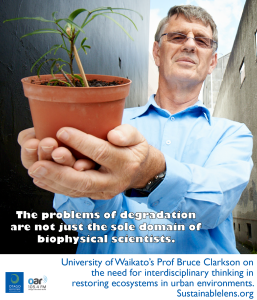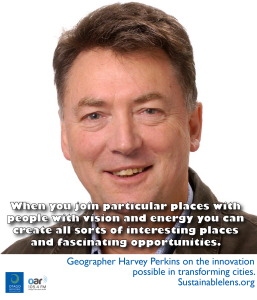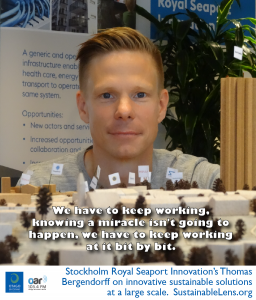
The problems of degradation are not just the sole domain of biophysical scientists.
Professor Bruce Clarkson is Dean of the Faculty of Science and Engineering at the University of Waikato, and is the Interim Director of the Biological Heritage National Science Challenge. He is recognised as one of New Zealand’s foremost authorities on ecological restoration. We talk about his background, what we learnt from island and mainland sanctuaries, and the opportunities and challenges of restoring ecosystems in urban environments.
Talking points
Most people don’t experience nature in a way we did in previous generations
How might you restore indigenous nature in an environment where people can access them more easily?
New Zealand has extremely high levels of endemism…if we don’t look after these native plants and animals, no one else is going to do it…this is our responsibility.
This is our biological heritage, this is what makes NZ special and different, it’s our responsibility as stewards of the land to maintain our natural heritage.
What you are really trying to do is manage the whole system, but a focus on birds will have positive spinoffs for the rest of the ecosystem
So what you are trying to achieve in the longer term is a recovery of the whole system, not just the bird populations.
It has to be a mix and match of approaches and a portfolio of places.
We’re working for the very long term so we have to build resilience into the system.
If we don’t do it, we will be responsible for the extinctions because we brought in the agents of change.
If we protect species, we protect their house.
We can treat our native birds as the umbrella species for the whole system that we’re trying to maintain, protect and restore.
Cities have some advantages over wildlands in terms of protecting native plants and animals…just think of the example of grazing animals.. you don’t have to confront the problems of goats and grazing cattle.
Looking after your own backyard and being a steward of something you cherish.
Start at a scale you can manage, have a plan and progressively recover what you are trying to achieve.
You can make big mistakes, the classic mistake people make in gully restoration is that they bite off more than they can handle.
I tend to be an optimist. Yes, there’s a lot of negative out there, and there’s a lot of degradation of the environment still going on. It would be an interesting research question, what would be the threshold point at which recovery tipped the balance back to the point where there was more improvement going on than degradation? I think in some points in our region we are very close to that threshold. Overall it is still a fact that New Zealand is still losing things. Forests are being cleared, wetlands are being drained, nowhere near the rates they were previously when we were in the land development phase, but some of that is still going on. There are large parts of the Department of Conservation estate where there little active management is occurring, and those areas are also going backwards. But the point is that there are significant areas where we are making a difference. So I see it in a more optimistic way. Know also, that we do have the technologies to do more and more of this restoration, it’s really a question of how much time, effort and funding is New Zealand as a nation prepared to put into it to get us to the threshold of recovery at regional and national scale.
We’re trying to bridge the interdisciplinary gaps.
The point is how we deal with interdisciplinary problems.
The problems of degradation are not just the sole domain of biophysical scientists. To get the results that you want you need expertise in a wide range of areas. This is another advantage of working in urban areas, there are a lot of professions, all with interests in how we might restore urban environments.
We want engineers who not only know about engineering, but know about the environment as well.
I think the solutions to most (environmental) problems are actually about how we build bridges between the different disciplines…to come together and work collaboratively.
Increasingly, graduates from university are expected not just to know about their discipline, they are expected to work in multidisciplinary teams, on projects where people are trying to achieve solutions to particular problems.
It’s not just about a technical fix, it’s about understanding how you can do things in different ways, often the ways things use to be.
Restoration ecology is difficult, reconstructing an ecosystem takes time, but if you go into it knowing that and how the system works, you can make a long term plan for restoration, a plan for a process that might be inter-generational.
A 500 year plan, with milestones along the way
Once you’ve started a project, once you see process, people take pride in the process. It’s quite inspirational what a change you can make on the landscape in such a short time.
(Activist?) People who work in universities in many respects are people who love ideas, and love the debate around ideas – and if that is what an activist is, then essentially that’s what you are. You’re looking at systems, you’re understanding the system, and you’re trying to pass on your knowledge of how best to manage that system in an effective way. If that is what an activist is, then that’s what you are.
(Motivation?) Students, seeing the progress my students make, and where they end up. Being able to contribute to knowledge and process. The process of protecting and restoring plant communities and the animals that go with them – for some reason as a child that gelled with me, and I’m still passionate about achieving the same thing. Making a difference.
(Challenges?) Staying fit and healthy and keeping going.
(Miracle?) A silver bullet for pest control. Some new way that is socially acceptable for controlling mammalian predators that prey on our native birds. That would very rapidly and radically alter our landscape.
(Advice?) Look around your own neighbourhood, find out who are the people doing this sort of work and go along and give them a hand because they need all the help they can get.



